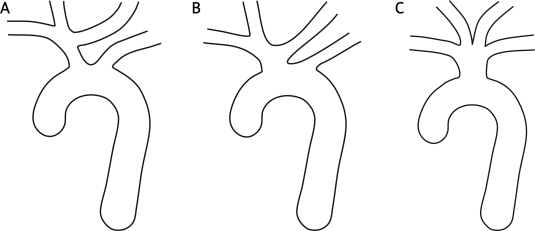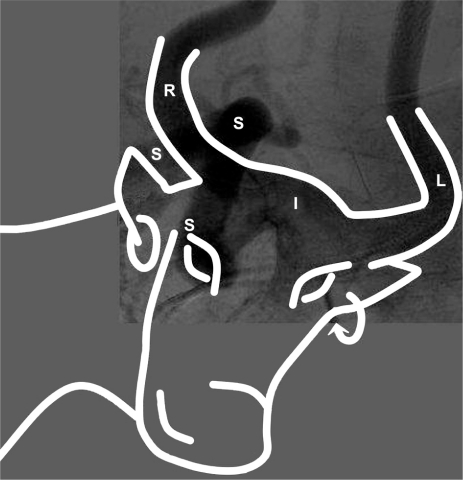Bovine aortic arch refers to the most common variant of aortic arch branching in humans. This configuration can be found in approximately 27% of the population and can be further divided into 2 subtypes. In the less usual subtype (7%, Figure 1 – panel A), the innominate artery (usually 1-2.5 cm long) trifurcates into the left common carotid artery, the right common carotid artery and the right subclavian artery, while the more usual subtype (although angiographically less apparent) can be described as the common origin of the innominate artery and the left common carotid artery and can be found in approximately 20% of the population (Figure 1 – panel B). Both of the subtypes occur more commonly in blacks compared with whites [2].
Figure 1.
A – Bovine arch – left common carotid artery originating from the innominate artery. B – Bovine arch – common origin of the innominate artery and left common carotid artery. C – True bovine arch
Although the term “bovine arch” evokes resemblance with the aortic arch branching configuration found in cattle, the “true bovine arch” (Figure 1 – panel C) found in cattle bears no resemblance to any of the common aortic arch variations found in humans. Paradoxically, the bovine arch is considered a norm in rodents and beasts of prey, and it was its angiographic appearance from which its name was derived (Figure 2).
Figure 2.
Bovine arch pattern scheme – common origin of the innominate artery (I) and left common carotid artery (L) subtype. Right subclavian artery (S). Right common carotid artery (R). Diagnostic catheter (arrow)
Nevertheless, it is of great importance for physicians to be familiar with the knowledge of aortic arch branching variations, especially in the field of carotid interventions. In particular, when the left internal carotid artery is the target artery for carotid artery stenting and the procedure is performed via the femoral artery, passage of the sheath through the bovine arch is around an acute angle and can become very challenging.
It is now evident that gaining access to the target vessel plays a key role in carotid artery stenting. Bovine arch, elongation, angulation or calcification of the aortic arch, and stenosis at the origin of branching vessels are the greatest predictors of difficult access, and cumulate in older patients. This must be taken into consideration especially in the light of the recently published Carotid Revascularization Endarterectomy versus Stenting Trial (CREST) [3], which revealed a significantly higher proportion of cerebrovascular events during carotid angioplasty and stenting in octogenarians compared to younger patients. However, carotid artery stenting should be performed in high-volume centres that have good experience with “complex carotid interventions” and documented low periprocedural stroke and death rates.
References
- 1.Schneider P. Advanced cerebrovascular arteriography: applications in carotid stenting. In: Schneider P, Bohannon W, Silva M, editors. New York: Carotid interventions. Marcel Dekker; 2004. pp. 69–91. [Google Scholar]
- 2.Lippert H, Rabst R. Aortic arch in arterial variations in man classification and frequency. Munich: JF Bergmann-Verlag; 1985. pp. 3–10. [Google Scholar]
- 3.Brott TG, Hobson RW, 2nd, Howard G, et al. CREST Investigators. Stenting versus endarterectomy for treatment of carotid-artery stenosis. N Engl J Med. 2010;363:11–23. doi: 10.1056/NEJMoa0912321. [DOI] [PMC free article] [PubMed] [Google Scholar]




